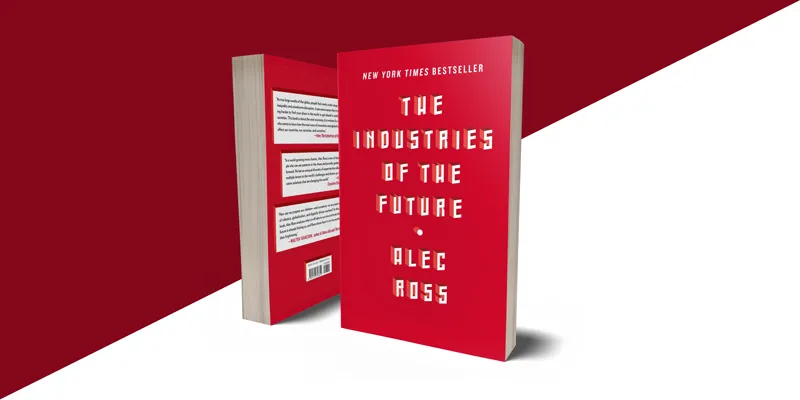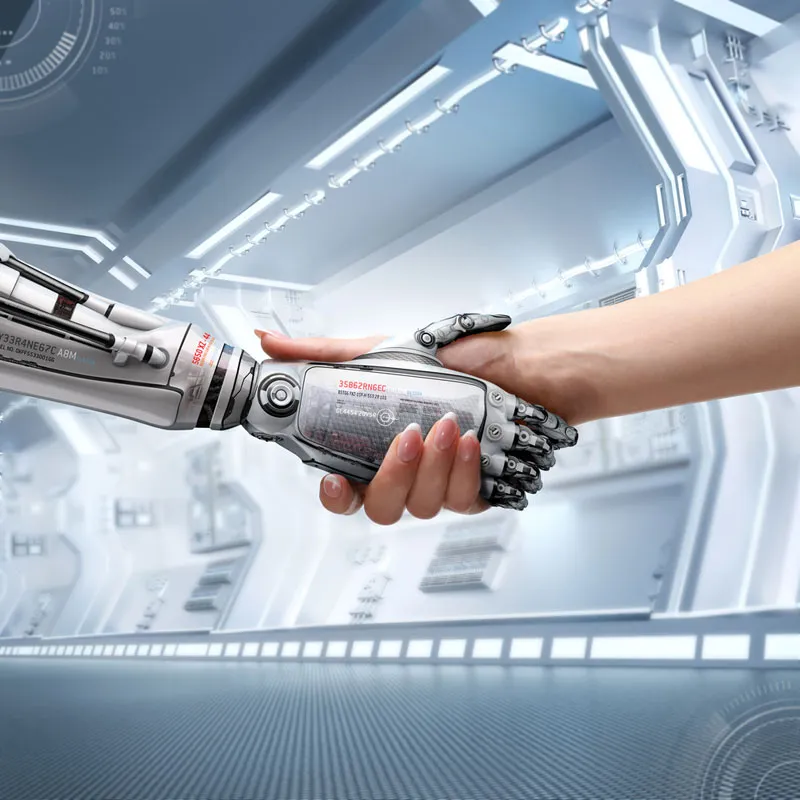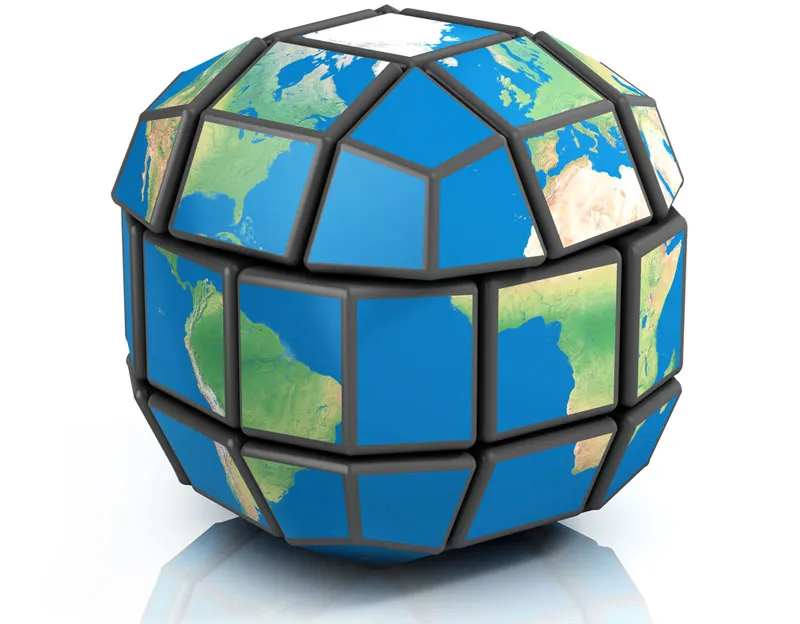Industries of the future: The race for robotics, genomics, analytics, cybersecurity and digital transactions
Exponential technology growth is transforming the world in ways never seen before, opening up new entrepreneurial opportunities while also causing wrenching socio-economic change. The new book The Industries of the Future points out examples, trends and success factors in sectors ranging from robotics and cybersecurity to genomics and analytics (see also my review of the book No Ordinary Disruption).

As Senior Advisor for Innovation to the US Secretary of State, author Alec Ross traveled to over 40 countries. He is a Distinguished Visiting Fellow at the Johns Hopkins University and serves as an advisor to investors, government and industry. In 2000, he and three colleagues co-founded the social venture One Economy.
The 305-page book is a good mix of storytelling and economic analysis, backed up by 40 pages of reference citations. I have clustered some of the startups and innovative organisations in these booming sectors in Table 1, followed by brief overviews of each of the five sectors.
Table 1: Innovation by sector
Robotics
The word ‘robot’ was first coined by Czech sci-fi writer Karel Capek. The ‘singularity’ – the point when AI surpasses human intelligence – could come by 2023 (Vernor Vinge) or 2045 (Ray Kurzweil). ‘Weak’ AI (in specific functions) is advancing exponentially, but ‘strong’ AI (human-like cognition) is growing only linearly. While much attention focuses on robots doing human tasks, they may soon be doing things impossible for humans.
Robots are well suited to a wide range of tasks – dangerous, dirty, dreary, as well as context-sensitive, spatially dexterous and judgment-focused. Robots have high cap-ex but relatively low op-ex, as compared to routine tasks requiring high human op-ex (salaries) but low cap-ex (training). Robots can free humans to do more productive things, but there will be labour and cultural repercussions on society as robots impact blue-collar as well as white-collar work.
Smart cars may help reduce accidents caused by the ‘four Ds’ – distraction, drowsiness, drunkenness and driver errors, but issues of trust and the ‘human touch’ still remain. “The driverless system will have to prove to be nearly perfect before it scales,” cautions Ross.
Trends to watch include robot-assisted surgery, educational robots (eg. for autistic children), cloud robotics for connected learning (breaking free from the confines of in-circuit memory and logic), materials such as air muscle, and small components for nanobots.
Japan leads the world in robotics, industrial as well as eldercare, followed by China, the US, Korea and Germany (in terms of robot sales). Japan is home to the longest-living people on the planet and has the largest population of the elderly. It is also tough on immigration. The country has a favourable cultural predisposition towards robots, thanks to Shinto animist beliefs, and is reinventing robotics the way it reinvented cars in the 1970s and consumer electronics in the 1980s.
Examples include Toyota’s ‘female’ nursing aide Robina and her ‘ brother’ Humanoid; Honda’s ASIMO (Advanced Step in Innovative Mobility) healthcare companion; RIKEN’s RIBA (Robot for Interactive Body Assistance) caretaker, which can even lift humans; and AIST’s PARO, a robot seal pet. Robots will be that rare technology that reaches elders first.
Other examples include Korea’s jellyfish-eliminating robot swarms, Panasonic’s hairwashing robot (for salons and hospitals), Motoman’s waiter robots, and Manchester airport’s robot janitors. China is also investing heavily in robotics as it faces labour cost competition from other countries like Vietnam.

Genomics
Genomics, the next trillion-dollar industry, took off in the mid-1990s, and the cost of genome sequencing dropped a million-fold in 10 years. Genomics can help detect and treat cancers at early stages, target genes that cause depression and suicidal behaviours, and even lead to ‘designer babies.’ Individualised drugs could be as important a change in medical practice as the introduction of anesthesia in the 19th century.
Other related developments include ‘medical hacking’ to unearth new insights into the human brain, aggregated databases to advance research into autism and Parkinson’s disease, the creation of products to slow down the process of ageing (Human Longevity Inc.), and even bringing extinct species back to life (Revive and Restore Project).
The Beijing Genomic Institute is now the largest genomic research centre in the world, with more sequencing machines than all of the US. China is becoming the third-largest producer of science and engineering academic articles (after the EU and US).
Digital advancements in the medical field also include mobile health. For example, Medic Mobile uses a smartphone light and camera to diagnose malaria and tuberculosis in Africa; MedAfrica apps help Kenyans with symptom diagnosis and doctor appointments; the Eye Netra device and app assist eye doctors with remote diagnosis; and medical analytics could be offshored to parts of the world with the requisite skill sets.
Code-ification of money, markets and trust
Digital algorithms are redefining the way trust has been negotiated between citizens, companies and governments. Just as the internet disrupted the information, communication and commerce industries in its first 15 years, it may now disrupt banking, law and accountancy.
Platform creation is the new wealth, and this will also lead to concentration of wealth in the market leaders and their regions, Silicon Valley being a prime example. There will be legal and socio-economic repercussions in terms of wage levels and worker protection laws.
eBay first helped traders trust total strangers on a massive scale; marketplaces for services have extended this model (see my book review of Peers, Inc). Uber is worth more than double the value of Hertz and Avis combined, and can dominate related sectors like delivery. AirBnB is worth more than twice as much as Hyatt, allowing people to travel cheaper and longer, and now even offers castles for rent.
Square is helping small businesses and consumers transact, redefining offline local experiences, and even building new consumer profiles for potential loans based on spending pattern analysis. Approximately 25 percent of Kenya’s GNP flows through the M-Pesa network, which offers payment and loan services as well as salary payments. Zain Zap promotes mobile remittance services. LinkedIn founder Reid Hoffman has also invested in Xapo, which has built a network of underground vaults storing private keys and cryptographic materials.
In terms of cryptocurrency, BitCoin is the leading player, based on P2P trust networks, public ledgers, and distributed blockchains with embedded history. New governance structures and firms will emerge, analogous to the rise of DNS for internet communication.

Cybersecurity
We seem to have moved from an era of ‘Cold War’ to ‘Code War’ with the rise of cyberattacks on confidentiality, availability and integrity. The cost of cyberattacks has crossed $400 billion a year, more than the GDP of 160 countries. Cybersecurity could be a $120 billion market by 2017.
The Shamoon-Distrack attack brought down IT services and business activity in Saudi Aramco and RasGas. A payments system attack on retailer Target cost it billions of dollars in market value. DDoS attacks have brought down independent news sites in Hong Kong and websites of Estonian banks.
North Korean sites attacked Sony Pictures’ emails and data after a movie about a fictitious assassination plot against their leader. The Twitter account of Associated Press was hacked in 2013, and false news circulated. Many companies and countries have had trade secrets stolen online.
Unfortunately, cyber risks will continue to increase in frequency, scope and methods, thanks to the rise of IoT (hackers and malicious thing-bots in connected cars, wearables, grids). Barriers to entry for cybercriminals are much lower than for other types, but many companies continue to implement security as an afterthought.
Startups will be a growing source of insights and solutions for implementing cybersecurity. “Cybersecurity is going to be very similar to Silicon Valley startup and acquisition patterns,” says expert Chris Bronk. This field is becoming a steady source of well-paid employment as well.
“Liberty without security is fragile, and security without liberty is oppressive,” cautions Ross, pointing to the tradeoffs that people will have to negotiate. Security will be a combination of public good administered by the government and private good purchased in the marketplace.
Data: The raw material of the information age
Digital storage became more cost-effective than paper systems for the first time in the 1990s. Ninety percent of the world’s digital data has been generated over the last two years alone. Increases in data gathering and computing power have turned analytics into ‘both a microscope and telescope’ for sense-making and forecasting. Big Data and analytics are transforming everything from supply chains and agriculture to advertising and elections (see my book reviews of Big Data and Big Data Revolution).
The quality of automated translation is improving thanks to more data, more computing and better software; users can flag correct and incorrect translations in real-time. This can lead to the loss of jobs for translators, but can also accelerate globalisation through better understanding of multiple languages.
Precision agriculture in the digital age can help farmers with what to do, as well as when and where, as exemplified by Monsanto’s FieldScripts recommendations and FieldView app. Agriculture firms will have to continue to acquire the most promising startups to stay ahead of the curve, says Ross.
Countries like India can gain much from smart farming. “No other country has suffered more from a lack of farm modernisation than India,” says Ross. There have been 300,000 farmer suicides in the past 20 years, and 25 percent of the world’s hungry live in India (190 million).
In the financial world, fintech startups are forcing large institutional banks to invest in their own technology overhauls. “Engaging with the startup and venture capital community forces us to think about innovation in a different way, more revolution than evolution,” says David Reilly, tech executive at Bank of America.
Zac Townsend, founder of startup Standard Treasury, sees banks as data companies. But traditional banks have antiquated data systems, which has made them inefficient and un-innovative in storing value, moving value and pricing risk in real-time.
During the 2012 US presidential campaign, the Obama campaign sometimes tested 18 variations of a single email to see which was most effective for fundraising. Data modeling, summarisation and visualisation have helped Palantir manage massive and often messy data for the security and securities industries.
However, defining and defending data privacy will become a major issue. “Technology is transforming us into brilliant fools,” warns critic Leon Wieseltier. Data ownership, quality and processing needs to come under intense scrutiny.
There are huge differences between the ‘always off’ generation of earlier times and the ‘always on’ generation of today and the future. A big challenge today is work-life balance, and knowing where to draw the line between public and private personas.
Globalisation
In addition to the above tech trends, one chapter in the book addresses geographic dimensions of innovation. Many countries have tried to create their own versions of Silicon Valley, but without much success, especially when it comes to ambition, meritocracy, culture and labour-market characteristics.
Pockets of excellence are emerging around the world, such as cybersecurity in Russia and Israel, Industry 4.0 in Germany, e-society in Estonia, and hybrid development models in Singapore, China and India. “The single most successful country of the last half-century is South Korea,” says Ross.
Openness of society and opportunities for women entrepreneurs are important success factors in the long run. The ‘girl geek’ phenomenon in Indonesia is a good example of women entrepreneurship in a society that has embraced Islam.

“China and India are both grappling with the growing need for openness in their own ways,” says Ross; Brazil is also struggling to get its model right. “India is a country increasingly defined by technology, global services and a fast-growing middle class,” he adds, pointing to the Aadhar initiative as a potential game-changer (see my book reviews of China’s Disruptors and Recasting India).
“The progress of women in Chinese society over the course of decades is one of the major reasons it is the economic power it is today,” says Ross. “Infrastructure is super-developed in China but under-developed in India,” observes economist Nouriel Roubini. India also needs to commit itself to primary education for all citizens.
“Africa’s entrepreneurs are now changing the face of the continent, fueling development and creating a new class of globally competitive businesses,” says Ross, pointing to Grainy Bunch, iCow, Andela Fellows and Apps4Africa as examples (see my book review of Success in Africa: CEO insights from a continent on the rise). But on another continent, Argentina is being held back by ‘control freak economics.’
Economic returns in these future industries will be unevenly distributed. Many people around the world are feeling under siege, and feel that it is harder to get ahead. “Many people will gain. Some will gain hugely. But many will also be displaced,” Ross cautions.
New forms of social anxiety and fraud are arising, and new ways to cope will have to be devised by individuals, families, societies and countries – ranging from competitiveness to parenting. The global mindset, cultural curiosity, inter-disciplinary skills and multi-cultural fluency will be key requisites for success (see also my book review of Creative Confidence). “Ironically, in a world growing more virtual, it has never been more important to get as many ink stamps in your passport as possible,” Ross jokes.
“Future growth depends on empowering people. Innovation and globalisation have created opportunity the likes of which has never before existed,” Ross sums up.







